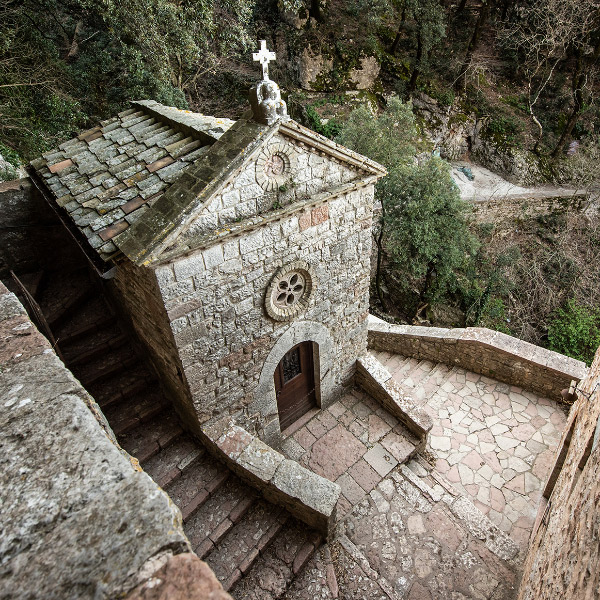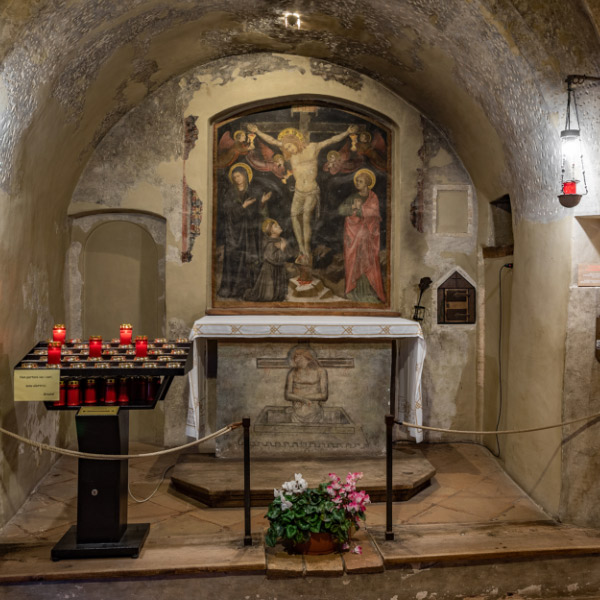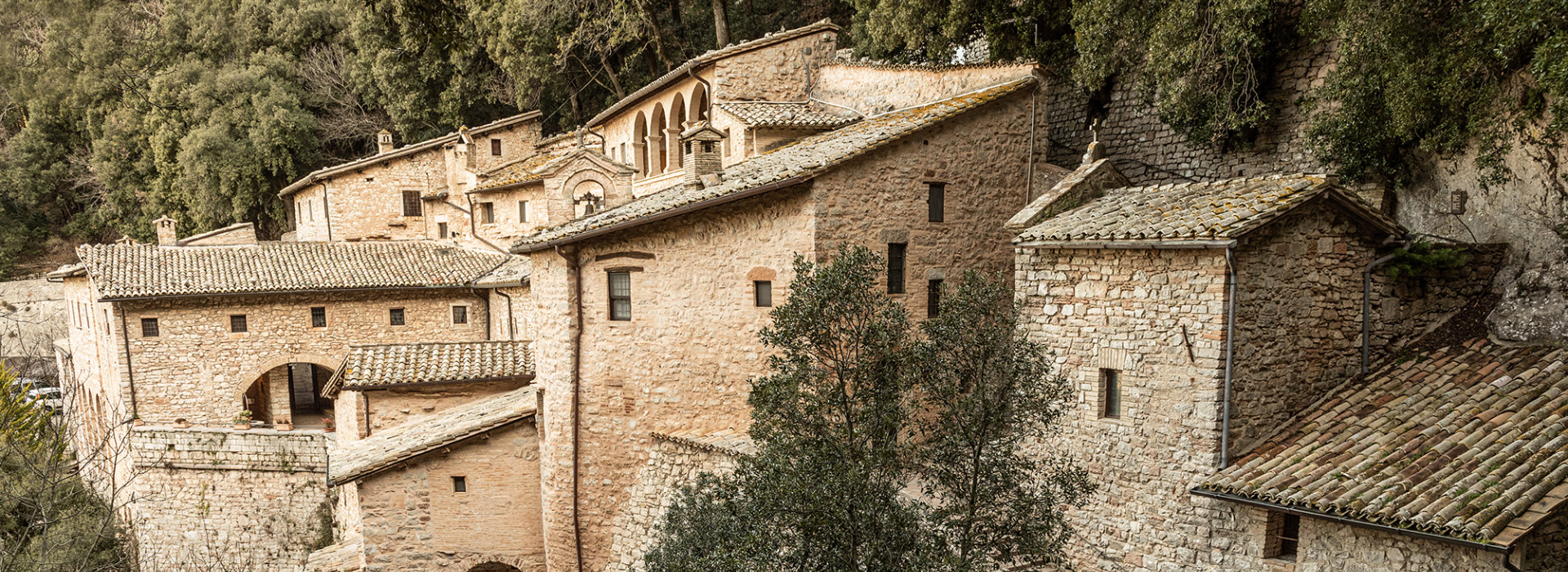History of the Hermitage
The natural caves of this big rock were used by the Friars as cells. You may visit the small Oratory where they gathered for common prayer, Eucharistic Celebrations and sharing experience of God along their days marked by prayer. Towards the 14th Century, the Friars started to live here in very poor shelters. At the beginning of 1400, with Saint Bernardine of Siena, a small Church was built, the Choir, the Refectory and a Dormitory against the rocks with small cells for the Friars. More buildings followed in later centuries as needed at the time. Throughout the centuries, many Friars known for their sanctity lived here, such as Beato Antonio da Stroncone, Beato Francesco da Pavia and San Giacomo della Marca.
Visit of the Hermitage
A short visit in seven steps, each with photo and short description:
The small Cloister
The Hermitage in the rocks leads us in a very special way to the discovery of Creation, Nature, and the works of the Lord, thus revealing his Love. Francis vibrated with joy when contemplating nature, his eyes lost in the green and his mind in God. In the incredible tenderness of the Umbrian landscape, he contemplated the marvels of the Lord; he spoke with love to the larks and to all animals.
From this terrace, our eyes almost anxiously seek - in the very green wood around - the first disciples of the Saint and all those who climbed up here, in this solitude so full of God and silence.
In eight centuries of Franciscan history, hundreds of Friars stayed here to gain energy, grace and light for their immense task: change the world with the revolutionary leaven of the Gospel and poverty so as to become generous donors of spiritual wealth to all men.
Here they are … you can almost see them, concentrated in prayer in the semidarkness of their humble caves, surrounded by green beeches and holm-oaks with their shiny leaves, in this sea of profound silence where only nature seems to breathe.
The well of Saint Francis is in the small Cloister, from where you join the little Friary, the ancient Church and the Chapel of Saint Mary, followed by the cave of the Saint (link «The Cave of St. Francis»). A little bridge leads to the other side of the wood.
The small Friary
The Sanctuary of the Eremo delle Carceri on the rocks of the mountain was extended throughout the centuries with the creativity of the poor. In the 15th Century, with Saint Bernardine of Siena, a very small Friary was built on the ancient hermitage, a masterpiece of simple and perfect Franciscan harmony.
This small Friary stands out within the intense green of the wood and the scent of the plants around, like an eagle’s nest looking over the busy valley: its splendid architecture is of sober simplicity, tenderly set in nature to serve spirit and life.
The access to the small Friary is through the Refectory carved in the rock.
It is as if it wanted to express its solid joy to share everything with the Friars, signifying the ineffable presence of the Lord to those who are together in His name. This is where poverty, mortification, strength and prayer become real and make themselves visible.
There is a short corridor above, where the cells of the Friars cling to the mountain, expressing clearly – in its nude and untouched simplicity – the spirit of poverty that has since flourished in the Order of Minors following the great example of Francis’ life.

Chapel of Santa Maria Maddalena
Here is the tomb of Fra Barnaba of Terni, in 1462 originator and founder of “Monte di Pietà” (mount of piety) in Perugia: an institution that grants loans to people in need without interest, just with something given in deposit (loan on security).
This refers to an important Gospel message, announcing at the same time God’s love and solidarity towards brothers in need.

Oratory of Saint Mary
There is access from the little Cloister to the Church of the 14th century with a small bell-tower, inviting to contemplation with its Altar and tiny Choir. Next to it, the ancient Oratory of Saint Mary is witness for prayer of Francis and the first community: it is the very small Oratory where the Saint and his companions met for common prayer.
Wherever Francis could find a place for a small church where to pray, he kept the same style as Porziuncola and always dedicated it to the “Mother of every Grace”.
Next to the small Church there is a tiny Choir where the Friars would chant psalms, read in the only breviary and silently adore the Lord, loving Him.
Seal of Saint Bernardine of Siena
The initials of the name of Jesus the Saviour of Men (IHS) within a disc representing the sun.
« Jesus Light of People » is a frequent topic in the preaching of Saint Bernardine of Siena.
The Cave of Saint Francis
When Francis first came here, he only found natural caves in the heart of this thick wood. They impressed their taste and architecture to the buildings, that were respected with veneration in the centuries.
A steep passage leads down to the cave of the Saint!
Indeed Francis had put his nest in the rocks, and almost like a prisoner among these stones, he merged more and more profoundly into meditation of the passion of his Lord, so that - clinging to the rocks - the memory of Christ’s death became even stronger.
For Francis, Christ represents the stone, and he remembered how the rocks split up when the Lord died.
At night he stretched out his fragile body exhausted from penitence and fasting on the nude stone.
The holm-oak, the wood and the valley
A bridge connects the Eremo with the other side of the wood, where the caves of Friar Leo and other companions of the Saint can still be seen. Our look falls on the century-old holm-oak, so that we can almost hear again the Saint’s preaching to the birds, full of love:
«My brother birds, you should greatly praise your Creator, and love Him always. He gave you feathers to wear, wings to fly, and whatever you need. God made you noble among His creatures and gave you a home in the purity of the air, so that, though you neither sow nor reap, He nevertheless protects and governs you without your least care». He himself, and those brothers who were with him, used to say that, at these words, the birds rejoiced in a wonderful way according to their nature. They stretched their necks, spread their wings, opened their beaks and looked at him… Then he blessed them, and having made the sign of the cross, gave them permission to fly off to another place.»
The mountain’s gorge is not closed, but opens up in two huge ribs towards the Umbrian plain. Their wideness seems to embrace the world like two vigorous arms, as did Francesco and his brothers when they went down to the valley, strong in spirit, to announce to everybody the Lord’s love, tenderness and mercy.
